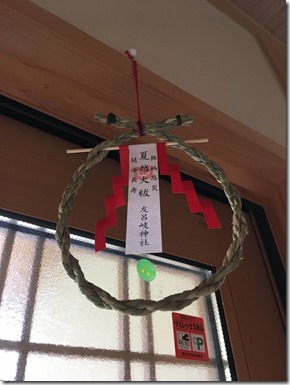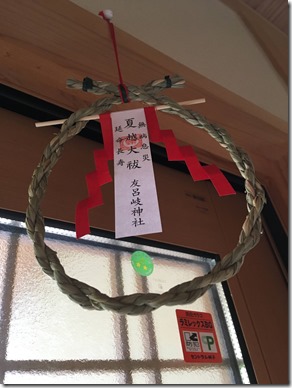大祓い神事
憧れの入院生活を終え昨日無事退院。で、憧れの入院生活は?、となるのですが、正直な感想は、一度経験したからもう二度とは結構って感じ。
「三食昼寝つき」はその通りでしたが、ベットからは自由に動けず、点滴やら何やらで身体の周りは管がいっぱい。しかも手術で半身麻酔をされたが、これが凄い。下半身は全く感覚無し。術後まっすぐベッドに寝ていた様ですが、自分の感覚は足が曲がったままの感じ。従って真っすぐに伸ばそうと思うが、指一本動かせない。看護師さんに「足を伸ばしたいのですが・・」と言うと、「足はまっすぐに伸びていますよ」とのこと。エッ、そんなことは無い。今度は先生に尋ねると、先生曰く「麻酔を打つ前に足を曲げていたので、その感覚がそのまま残っているのでしょう・・」とのこと。そうかと納得はしたものの、麻酔の威力をしっかりと体感し、ただただ感心し驚いた。そして同時に麻薬の恐ろしさを知らされた。
そんなのだから憧れの三食昼寝付きも、思ったほど快適では無く、昼寝どころか夜もろくに眠れず、疲れて思ったほど本も読めず、良かったのは看護師さんがよくしてくれた事くらい。
よって、予定通り退院できホッとした、というのが正直なところ。
病院に居れば病人になるが、退院すれば元気モリモリ。そこで今日は朝一番に自宅から徒歩20分程の所にある「友呂岐神社」で、半年に一回の大祓いに行ってきた。
大祓い神事というのは、以下(ウィキペディア(Wikipedia))のとおり。
大祓(おおはらえ、 おおはらい)は、日本の神道儀式の祓の1つ。祓は浄化[注釈 1]の儀式として宮中や神社で日常的に行われるが、特に天下万民の罪穢を祓うという意味で大祓という[1]。毎年6月と12月の晦日、すなわち、新暦6月30日と12月31日に行われるものを恒例とするが、天皇即位後の最初の新嘗祭である大嘗祭の前後や、未曾有の疫病の流行、斎宮斎院の卜定、災害の襲来などでも臨時に執り行うことがあった。中臣(なかとみ)の祓とも言われる。
願うのは「無病息災、延命長寿」。同時に疫病(コロナ)祓い。上記の通り大祓いは、6月30日と12月31日に行われるが、神社本殿の正面に造られた大きな円形のしめ縄の中をくぐり左に回り、次に右に回り、再度おお縄をくぐって本殿にお参りする。
ここ何年かは都合がつけば、お参りするようにしているが、今回は特に退院翌日という事もあって、真剣にお祓いをしてきた。
友呂岐神社で頂いてきた大祓いのしめ縄
purification rite performed twice a year, before daijôsai and after major disasters
Yesterday, I was discharged from the hospital after my longing for a life in the hospital. So, how was the hospital stay? Well, to be honest, after having experienced it once, I don’t want to go through it again.
The “three meals and a nap” was true, but I couldn’t move freely from my bed, and there were tubes all around my body with IVs and other things. In addition, they gave me a semi-general anesthesia for the surgery, which was amazing. I had no feeling in the lower part of my body at all. It seemed like I was lying straight on the bed after the surgery, but my sensation was that my legs were still bent. So I tried to straighten it out, but I couldn’t move a single finger. I said to the nurse, “I’d like to stretch my legs,” and she said, “Your legs are straight. What? That’s not true. This time, I asked the doctor, and he said, “You bent your leg before the anesthesia was given, so the feeling must have stayed with you. Although I was convinced that this was so, I was impressed and surprised to feel the power of anesthesia. At the same time, I was reminded of the horror of drugs.
I could not sleep well at night, let alone take a nap, and I was so tired that I could not read as much as I had expected.
The only good thing was that the nurses treated me well. So, to be honest, I was relieved to be discharged from the hospital as planned.
If I stay in the hospital, I’ll be a sick person, but if I leave the hospital, I’ll be full of energy. So today, first thing in the morning, I went to Yuroki Shrine, about a 20-minute walk from my house, for the semi-annual purification ceremony.
The ritual is as follows (Wikipedia).
Oharai is one of the purification rituals of Japanese Shintoism. Exorcism is a ritual of purification[note 1] and is performed routinely at the Imperial Palace and shrines, but it is especially called Oharai in the sense that it purges the sins and impurities of all people under heaven[1]. It is usually held on the last day of June and December each year, i.e., June 30 and December 31 of the new calendar year. However, it was sometimes held on an ad hoc basis around the time of the first Niiname Festival after the Emperor’s accession to the throne, or in the event of an unprecedented epidemic, the divestiture of the Saikyuu Saiin, or a disaster. It is also called Nakatomi-no-harae.
The wish is for “good health and longevity. At the same time, it is to exorcise the plague (corona). As mentioned above, the exorcism is held on June 30 and December 31. You must pass through a large circular shimenawa rope built in front of the main shrine, turn left, then turn right, and pass through the rope again to visit the main shrine.
For the past few years, I have been visiting the shrine whenever I can, but this time, especially since it was the day after I left the hospital, I took the purification seriously.
The shimenawa (rope for purification) that I received at the Tomoroki Shrine
Yesterday, I was discharged from the hospital after my longing for a life in the hospital. So, how was the hospital stay? Well, to be honest, after having experienced it once, I don’t want to go through it again.
The “three meals and a nap” was true, but I couldn’t move freely from my bed, and there were tubes all around my body with IVs and other things. In addition, they gave me a semi-general anesthesia for the surgery, which was amazing. I had no feeling in the lower part of my body at all. It seemed like I was lying straight on the bed after the surgery, but my sensation was that my legs were still bent. So I tried to straighten it out, but I couldn’t move a single finger. I said to the nurse, “I’d like to stretch my legs,” and she said, “Your legs are straight. What? That’s not true. This time, I asked the doctor, and he said, “You bent your leg before the anesthesia was given, so the feeling must have stayed with you. Although I was convinced that this was so, I was impressed and surprised to feel the power of anesthesia. At the same time, I was reminded of the horror of drugs.
I could not sleep well at night, let alone take a nap, and I was so tired that I could not read as much as I had expected.
The only good thing was that the nurses treated me well. So, to be honest, I was relieved to be discharged from the hospital as planned.
If I stay in the hospital, I’ll be a sick person, but if I leave the hospital, I’ll be full of energy. So today, first thing in the morning, I went to Yuroki Shrine, about a 20-minute walk from my house, for the semi-annual purification ceremony.
The ritual is as follows (Wikipedia).
Oharai is one of the purification rituals of Japanese Shintoism. Exorcism is a ritual of purification[note 1] and is performed routinely at the Imperial Palace and shrines, but it is especially called Oharai in the sense that it purges the sins and impurities of all people under heaven[1]. It is usually held on the last day of June and December each year, i.e., June 30 and December 31 of the new calendar year. However, it was sometimes held on an ad hoc basis around the time of the first Niiname Festival after the Emperor’s accession to the throne, or in the event of an unprecedented epidemic, the divestiture of the Saikyuu Saiin, or a disaster. It is also called Nakatomi-no-harae.
The wish is for “good health and longevity. At the same time, it is to exorcise the plague (corona). As mentioned above, the exorcism is held on June 30 and December 31. You must pass through a large circular shimenawa rope built in front of the main shrine, turn left, then turn right, and pass through the rope again to visit the main shrine.
For the past few years, I have been visiting the shrine whenever I can, but this time, especially since it was the day after I left the hospital, I took the purification seriously.
The shimenawa (rope for purification) that I received at the Tomoroki Shrine











